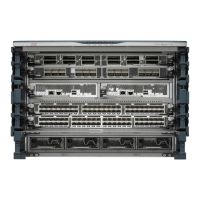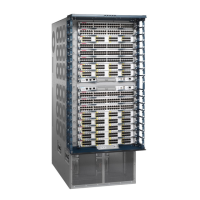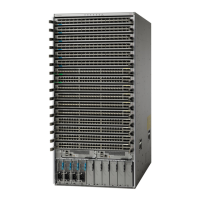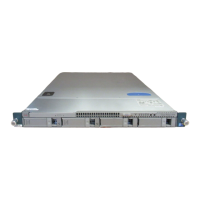10 Arbiter (s4) 125 105 61 Ok
10 CPU1CORE1(s5) 85 75 41 Ok
10 CPU1CORE2(s6) 85 75 37 Ok
10 CPU1CORE3(s7) 85 75 39 Ok
10 CPU1CORE4(s8) 85 75 38 Ok
10 CPU2CORE1(s9) 85 75 26 Ok
10 CPU2CORE2(s10) 85 75 23 Ok
10 CPU2CORE3(s11) 85 75 24 Ok
10 CPU2CORE4(s12) 85 75 22 Ok
10 DDR3DIMM1(s13) 95 85 30 Ok
10 DDR3DIMM2(s14) 95 85 28 Ok
10 DDR3DIMM4(s16) 95 85 25 Ok
10 DDR3DIMM5(s17) 95 85 26 Ok
switch#
Displaying Temperatures for Modules
Each supervisor, I/O, and fabric module has temperature sensors with two thresholds:
• Minor temperature threshold—When a minor threshold is exceeded, a minor alarm occurs and the
following actions occur for all four sensors:
• Displays system messages
• Sends Call Home alerts (if configured)
• Sends SNMP notifications (if configured)
• Major temperature threshold—When a major threshold is exceeded, a major alarm occurs and the following
actions occur:
• For sensors 1, 3, and 4 (outlet and onboard sensors), the following actions occur:
• Displays system messages.
• Sends Call Home alerts (if configured). For more information, refer Associating an Alert Group
with a Destination Profile .
• Sends SNMP notifications (if configured). For more information, refer Enabling SNMP
Notifications.
• For sensor 2 (intake sensor), the following actions occur:
• If the threshold is exceeded in a switching module, only that module is shut down.
• If the threshold is exceeded in an active supervisor module with HA-standby or standby present,
only that supervisor module is shut down and the standby supervisor module takes over.
• If you do not have a standby supervisor module in your switch, you have up to 2 minutes to
decrease the temperature. During this interval, the software monitors the temperature every 5
seconds and continuously sends system messages as configured.
Cisco Nexus 7710 Switch Site Preparation and Hardware Installation Guide
57OL-30452-01.
Managing the Switch
Displaying Temperatures for Modules
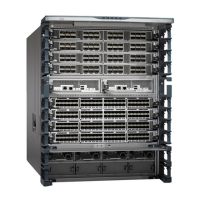
